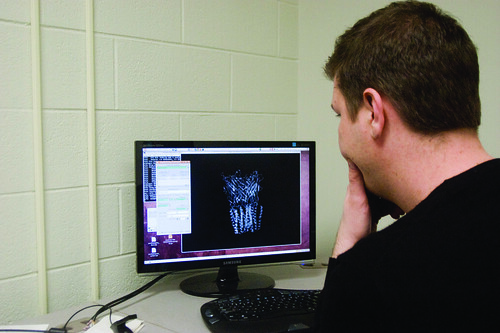Researchers from the Institute for Computational Molecular Science in the Bio Life Sciences building watch cutting-edge movies of molecules to determine how things work.
Surfactants are able to attach themselves to dirt molecules and wash them away when mixed with water. They are found in substances like shampoo.
Anesthesia blocks ion flowing channels, inhibiting brain activity and causing memory loss.

These are the kinds of subjects being studied each day within the Institute for Computational Molecular Science on the ground floor of the Bio Life Sciences building on Main Campus.
Rather than conducting experiments in a traditional wet lab, the 16 researchers at the institute use math and computers to see what’s happening at a molecular level.
“When you have a microscope in a lab, you can visualize what’s going on in a cell, but you can’t watch things happen. You can only look at a static picture,” explained Dr. Grace Brannigan, a research assistant professor. “If you want to watch a movie of a process that’s going on inside the cell, we don’t have the equipment to do that inside a lab. So one of the nice things that we can do is we can make these movies on the computer using what we know about the system from experiments that people have done and using the laws of physics.”
Similar to CPUs – central processing units – used in standard computers, the computers used by Institute researchers employ GPUs – graphics processing units.
Their research attracted attention from Nvidia, a computing technologies company and inventor of the GPU.
“What has been driving this market is gamers, like first person shooters, that kind of thing, to get better and better hardware in order to make things very realistic. It takes a lot of computer power to generate the background and everything, and so recently, people realized that these GPUs made by Nvidia and some other people for these games were actually great computers and great processors, and they could be used for science as well,” Brannigan said.
Nvidia worked with Associate Director and Research Associate Professor Axel Kohlmeyer and his fellow scientists conducting surfactant research to create a YouTube video.
The video showcases how computers, specifically GPUs, are used by the institute to model the behavior of surfactants under varying conditions, like pressure and temperature.
“What our group is interested in is really to understand the fundamentals of how surface active molecules work,” Kohlmeyer said in the video.
The video shows how the science behind shampoo is important because the hair-care industry is becoming more precise in various ways; for example, there are different washes for straight hair, curly hair and color-treated hair.
However, their study isn’t alone. There are also people in the lab looking into how the flu virus is spread, too, and others studying how anesthetics work.
The point of it all – progress.
“Anesthetics have been used for over 150 years in surgery, but we actually don’t have a very good idea of how they put you to sleep and how they make you immobile. Once you know how something is working, it gives you a better idea of how to develop better drugs. How to develop anesthetics without the bad side effect profiles we have with anesthetics today because we know what they need to be doing,” Brannigan said.
Before moving to Temple in August, the institute was operating out of the University of Pennsylvania.
“It didn’t exist [at Temple] before we moved here. Before we were here, this space was used to house dead animals, actually. There wasn’t really anything here,” she said.
The institute is still so new that there aren’t any students yet working there, but Brannigan said it’s a possibility for the future.
“Certainly students [at the undergraduate level] who want to spend the summer working in the lab are encouraged to stop by,” Brannigan said.
Michelle Provencher can be reached at michelle.provencher@temple.edu.


many people use herbal medicine to cure various diseases…
useful info… thank you